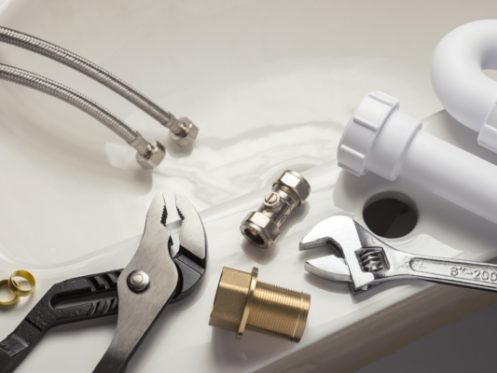Why Caulking and Grouting Plumbing Fixtures Is Important
Each of the plumbing fixtures in your Colorado home should have a tight seal around its perimeter. If it doesn’t, you may be at risk of moisture damage, mold, mildew, and countless other problems. Whether caulking or using grout, sealing plumbing fixtures is a critical part of protecting your home investment. Read on to find out why and to learn more about the different materials that are used.
Sealant Provides Waterproof Protection at All Joints
Plumbing fixtures are waterproof. Designed with completely non-porous materials, these home additions are built to route water down drains so that it doesn’t sit, which can cause issues. However, many of the building materials that surround your plumbing fixtures aren’t waterproof. More importantly, everything that sits behind them can absorb and be saturated by water as well. Thus, installing a barrier to protect these things is critical.
Without caulk, grout, or another sealant, every time someone splashes in the tub or is active at your kitchen sink, the nearby flooring, drywall, backsplashes, and baseboards could be affected. If water is allowed to enter the areas behind fixtures, you may have widespread water damage in spaces that you cannot see and cannot easily access.
Air Loss Prevention
Surprisingly, sealing your plumbing fixtures can also play a hand in preventing air loss and creating a tight home envelope. Even if cracks and gaps in building materials don’t lead directly outside, they can still allow warm air inside of your home to escape into the walls. Worse still, the air that’s exiting your bathroom will often carry a tremendous amount of moisture with it. As this air enters the rough framing, it can eventually wreak havoc on drywall, in-wall insulation, wood, and all other porous surfaces. By applying the right sealants, you’ll be improving the energy efficiency of your home and side-stepping a considerable amount of hidden moisture damage.
These seals are additionally important for ensuring that bathroom exhaust fans are capable of doing their job. If your bathroom fixtures aren’t sealed, humid air from hot showers and baths will flow into these spaces rather than being drawn out of the room through the intended ventilation. This is also true if you have a window for bathroom ventilation.
Pest Prevention
Every home should have a multi-pronged and needs-specific pest management plan. While pest treatment includes all of the targeted measures that professionals take to deal with active infestations, pest management is everything that homeowners do to prevent infestation. Although sealing up and properly storing food items is a critical part of this process, eliminating accessible water sources is easily the most important. Providing insects and animals with easy access to water sets the stage for pest problems. For instance, you’re far more likely to see thick trails of ants in your bathrooms or in the rooms that abut bathrooms when your plumbing fixtures are improperly sealed.
Grout Failure Is a Top Cause of Shower Leaks
Missing and deteriorating shower grout are both major causes of shower leaks. Although grout can promote beautiful bathroom aesthetics, it also serves a very functional purpose: protecting your home from water damage.
During the early stages of grout failure, tiles throughout the shower often loosen and fall. As water enters these openings, the drywall behind the shower can soften and crumble. This is also true of caulking. When caulking reaches the end of its lifespan, it can crack, peel, and pull away from plumbing fixtures. Failure at either of these seal types is always problematic.
Grout typically lasts between eight and 16 years. However, it will likely fail much sooner in high-traffic and high-moisture areas. If you purchased existing construction and are not sure when your tile grout was installed, you should schedule an inspection. Paying to have your shower grout replaced, repaired, or resealed can be infinitely cheaper than dealing with widespread moisture damage.
The Importance of Grout Sealant
While making sure that your shower grout is visibly intact is essential, it’s also vital to ensure that the grout between your shower tiles is properly sealed. Just as grout protects the building materials that lie behind your tile and the tiles themselves, grout sealant protects the grout. Grout is a porous mixture of sand, water, and cement. Absent of a seal, water can enter your grout to cause mold and rapid deterioration. Unsealed grout can also harbor bacteria and many other pathogens. Sealing it off makes it possible to enjoy a safe, sanitary bathing and showering area.
Sealants that are applied to floor grout should be replaced about once every three to five years. Sealants that are applied to shower grout should be replaced annually. Although this is a maintenance task that many homeowners take under their own wings, it’s best left in the hand of professionals. Professionally applied grout sealant will ensure total coverage, lasting results, and absolutely no ingress for moisture.
When having grout sealants replaced, it’s also important to address tiled areas in the kitchen. For instance, if your kitchen sink has a tiled backsplash, you’ll want to have this grout inspected and resealed as well. Although it isn’t subjected to the same amount of moisture as shower grout, it is still considered a high-moisture space.
Different Sealants for Different Plumbing Applications
Grout is the most effective sealant in tiled areas, however, it isn’t the ideal solution for all of your plumbing fixtures. Moreover, it’s a never a standalone sealant for showers and sinks. In fact, professional plumbers have a number of sealants that they use to ensure total and long-lasting coverage at each fixture. Every sealant has its own unique composition, level of elasticity, and protective qualities. The most commonly used plumbing sealants include:
- Latex sealants
- Silicone caulk
- Butyl rubber
Latex sealants are typically used to seal joints around shower pans and bathtubs. They can also fill in nail holes and other holes created by hardware, cracks in nearby tile, and cracks in plaster or plastic elements. In like fashion, silicone is used to seal shower and bathtub joints between plumbing fixtures and nearby tile or other surrounding elements. Silicone is also effective for sealing metal joints in high-moisture areas such as those found in roofing gutters and at plumbing fixtures.
Butyl rubber is unlikely to be used as a sealant at your plumbing fixtures. However, it may be found at nearby windows or exhaust vents. It bonds well with wood, metal, glass, and plastic. If your bathroom or kitchen window is relatively close to your sink, shower, or tub, you may find a combination of butyl rubber and silicone caulking or latex caulking here.
Signs Your Grout and Caulking Are Failing
If you haven’t had your kitchen or shower grout sealed in more than a year, it’s probably time to do so. These sealants degrade and may even outright fail after approximately 12 months of constant moisture exposure. If you haven’t had your tile grout replaced in more than five years, it’s time to have it inspected. This is especially true if your grout is discolored or crumbly. New grout has a smooth, silky appearance and a single, seamless color. If you apply moderate pressure to your kitchen or shower grout and it begins to crumble, this is a definite sign of moisture damage and excessive wear.
Caulking that’s pulling away from fixtures, curled, discolored, or cracked should be replaced as well. New caulking should also be applied in any areas in which caulking is missing completely.
At Summit Heating & A/C, we’re committed to helping our clients save money and protect their home investments. We’ve been proudly serving residents of Denver, Colorado and the surrounding areas since 1998. We offer heating, cooling, plumbing, and indoor air quality services. If it’s time to reseal your plumbing fixtures, give us a call today!


